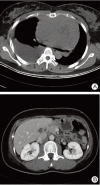Long-Term Survival after T-cell Lymphoblastic Lymphoma Treated with One Cycle of Hyper-CVAD Regimen
- PMID: 25152191
- PMCID: PMC4296853
- DOI: 10.4143/crt.2013.122
Long-Term Survival after T-cell Lymphoblastic Lymphoma Treated with One Cycle of Hyper-CVAD Regimen
Abstract
T-lymphoblastic lymphoma (T-LBL) is a rare form of aggressive non-Hodgkin's lymphoma. The standard approach for management of T-LBL involves intensive multiagent chemotherapy regimens for induction and consolidation phases with central nervous system prophylaxis and a maintenance phase lasting 12-18 months. We report on a case of long-term survival after one cycle of hyperfractionated cyclophosphamide, vincristine, doxorubicin, and dexamethasone (hyper-CVAD) and high-dose methotrexate. A 30-year-old woman diagnosed with T-LBL with a large mediastinal mass underwent one cycle of hyper-CVAD. Four days after the start of treatment, the mediastinal mass was markedly reduced. Treatment continued with one cycle of consolidation chemotherapy, comprising high-dose methotrexate and high-dose cytarabine. The patient then refused all further chemotherapeutic treatment. Seven years have passed without relapse.
Keywords: CVAD protocol; Precursor T-cell lymphoblastic leukemia-lymphoma; Remission induction.
Conflict of interest statement
Conflict of interest relevant to this article was not reported.
Figures




References
-
- A clinical evaluation of the International Lymphoma Study Group classification of non-Hodgkin’s lymphoma The Non-Hodgkin’s Lymphoma Classification Project. Blood. 1997;89:3909–18. - PubMed
-
- Portell CA, Sweetenham JW. Adult lymphoblastic lymphoma. Cancer J. 2012;18:432–8. - PubMed
-
- Sweetenham JW. Treatment of lymphoblastic lymphoma in adults. Oncology (Williston Park) 2009;23:1015–20. - PubMed
-
- Hoelzer D, Gokbuget N. T-cell lymphoblastic lymphoma and T-cell acute lymphoblastic leukemia: a separate entity? Clin Lymphoma Myeloma. 2009;9 Suppl 3:S214–21. - PubMed
-
- Raetz EA, Perkins SL, Bhojwani D, Smock K, Philip M, Carroll WL, et al. Gene expression profiling reveals intrinsic differences between T-cell acute lymphoblastic leukemia and T-cell lymphoblastic lymphoma. Pediatr Blood Cancer. 2006;47:130–40. - PubMed
LinkOut - more resources
Full Text Sources
Other Literature Sources

